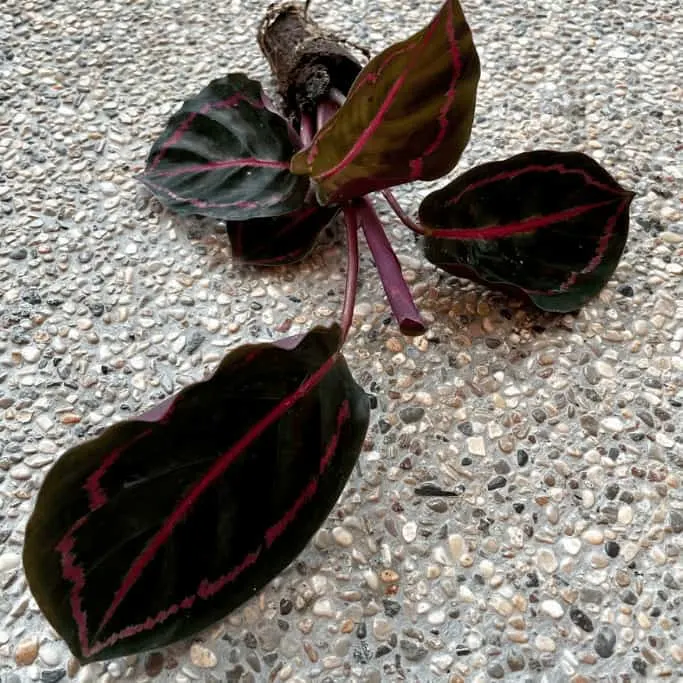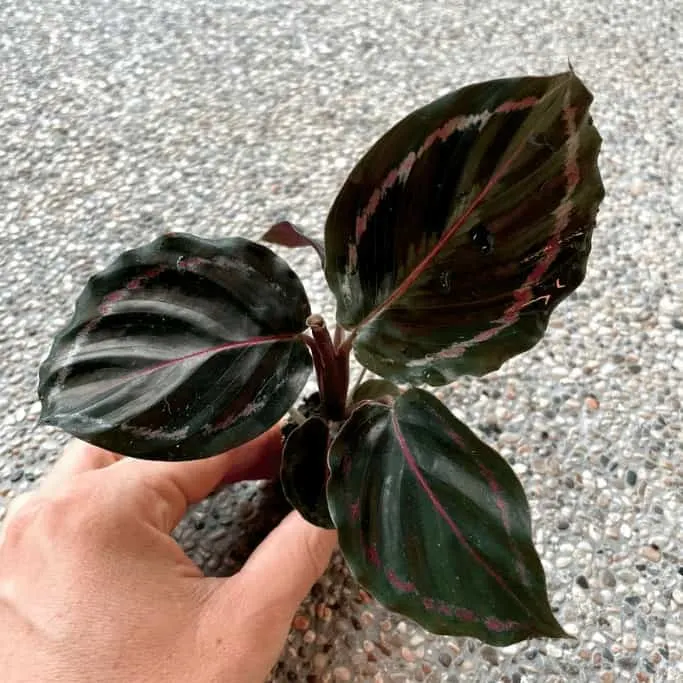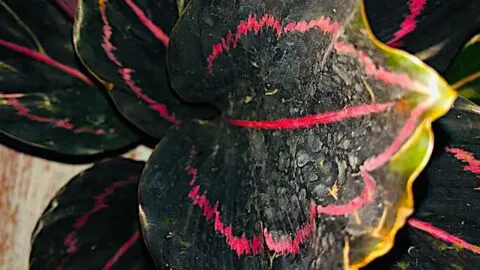Calathea Roseopicta is also called the Rose-Painted Calathea.
With large, flashy leaves this plant becomes the tropical statement.
But how do you care for this plant?
Calathea Roseoptica Care
Calathea Roseoptica prefers humid soil using a peat-based potting mix or regular potting soil with added perlite. It needs frequent watering about once a week or more as a general rule of thumb. Provide temperatures between 64 and 75ºF (18-24 ºC). It thrives in bright indirect light in a north, east, or west-facing window and high humidity above 60%. Fertilize once a month in spring and summer during the growing season using a balanced houseplant fertilizer at half-strength.
Table of Contents
The Calathea genus contains some of the most beautiful foliage plants according to the University of Florida.
Let’s, therefore, have a closer look at how to care for the beautiful Calathea Roseoptica.

CALATHEA ROSEOPICTA CARE
CALATHEA ROSEOPICTA CARE BASICS
Soil
For the best results use a peat-based potting mix or regular potting soil with perlite.
This will allow for proper drainage.
Choosing the correct type of soil is pivotal in maintaining a healthy Calathea plant.
This species needs soil that is moist, yet be careful to not overwater.
They grow on forest floors in nature and therefore need a substrate that can become slightly wet without ever becoming soggy.
Light
Placing Calathea Roseopicta in a location with indirect sunlight is best such as in a room that faces north, east, or west.
In order to keep those leaves vibrant, there needs to be a good amount of sunlight present.
If you put this plant in direct light, Calathea Rosepicta’s leaves will burn and become dull.
Watering
Water Calathea Roseopicta once a week or more depending on your environmental conditions, the size of the plant and roots and the soil and pot it is in.
As mentioned above, this plant prefers to live in a space where there is constant moisture without being oversaturated.
Their natural environment has a lot of humidity.
Pay attention to the leaves to see if your plant has enough water. If they are curling inward, add more water.
For leaves that become droopy, lay off on the moisture.
Temperature
Being a tropical plant, it is fairly obvious that they do not thrive in cold habitats.
The ideal temperature for a Calathea Roseopicta individual is between 64 and 75ºF (18 and 24ºC ).
Damage related to temperature does not become an issue until it reaches less than 15ºC (60ºF).
It is also important to avoid sudden changes in temperature, as this plant does not adjust well to such fluctuations.

Calathea Roseopicta plug plant
Humidity
Calathea Roseoptica thrives in a humidity of 60% and more.
As with other tropical plants, humidity is important for optimal growth.
Lower humidity might be tolerated by the plant but it will not thrive to its full potential.
Put your plant in a space where this level of humidity can be provided naturally or make use of a humidifier.
Fertilizer
Fertilize Calathea Roseoptica once a month in spring and summer using a balanced houseplant fertilizer at half-strength.
Your painted rose Calathea can benefit from fertilizer, yet it does not need this year-round.
The best time to add these substances is when the individual is producing new leaves in spring and summer.
Propagation
Calathea Roseoptica is best propagated through division.
These plants can be propagated during repotting time.
This process can easily be done through division where it is cut into separate sections with a knife.
Growth
Calathea Roseoptica reaches heights of up to 20 inches (50 centimeters).
This Calathea individual does not grow all that tall, nor does it mature quickly.
The leaves themselves are wider than they are tall.
Potting
Choose an adequate pot size for your Calathea Roseoptica that is only a couple of inches larger than the circumference of your plant.
You can always upsize but a plant pot that is just slightly larger than the circumference of your plant is best.
When the roots are still small
This pot should have the necessary drainage to avoid oversaturation.
Repotting is fairly easy, as it only needs this every two to three years.
Knowing how to properly care for your Calathea is vital in preserving this piece of artwork.
Learning about the origin of this species can help provide some background as to why it needs the correct amount of sunlight and humidity.
WHAT DOES THE CALATHEA ROSEOPICTA LOOK LIKE?
The Rose-Painted Calathea belongs to the family Marantaceae or the prayer-plant family.
This unusual name was given due to the fact that their large leaves face upward in the evenings as if they are praying.
This is done in order to absorb the optimal amount of water.
As with other members found in Marantaceae, Calathea Roseopicta’s leaves are wide and colorful, generally sporting a vibrant green.
They are named the Rose-Painted Calathea for the pink-colored stripes found along the middle portion of the plant, giving it a close resemblance to painting strokes.
The name was perfectly chosen as “roseopicta” translates to “picture of roses”.
Fun Fact:
Although these colorful leaves are famous for lifting in an upward position, they can also be found doing something else. Whenever the temperature gets too high, Calathea Roseopicta plants curl their leaves inward. The lack of water and humidity causes this change. – Plantophiles
THE ORIGIN OF THE ROSE-PAINTED CALATHEA
Calathea individuals can be found in the family Marantaceae, which comprises plants that originated in Africa. This is not, however, where Calathea Roseopicta is found.
This species is native to northwestern Brazil. A German botanical magazine illustrator named Regel Gartenflora in 1869 made the first recorded mention of the Rose-Painted Calathea.

New leaf emerging on Calathea Roseopicta
ONE PLANT, MANY NAMES
One of the fun jobs that botanists get is when they first decide on a name. For most living things, there are a couple of terms coined with a particular individual. This Calathea individual has only a few common names, including the Rose-Painted Calathea and the Rose-Painted Prayer Plant.
Fun Fact:
The most common among the Calathea subspecies is the Calathea Roseopicta Dottie. It is often preferred for the coloration in the leaves. Instead of sporting a light shade of pink, the midrib along the leaves is bright pink. The vivid pop of color is often a great tropical twist to any living room. – Plantophiles
PROPAGATION OF THE ROSE-PAINTED CALATHEA
There are a number of ways in which you can choose to propagate your Calathea Roseopicta plant.
Although it can be done through cutting, the most common propagation method is by division. Fortunately, this is an easy process.
The following steps can be followed in order to ensure that your plant is propagated correctly.
Step 1: Examine your pot to check for any overcrowding. If you see that the plant is cramped for space, consider moving on to step 2. You can either fix this issue through propagation or repotting.
Step 2: With your hands, gently spread the stems of the plant out so that there is some space in-between them. Follow up with patting down the soil.
Step 3: Once the stems are spread out, place a piece of newspaper on a flat surface. Carefully turn the pot upside down onto the newspaper so that it comes out of the pot.
Step 4: Now continue by separating the roots from the plant. Be sure that each stem has at least a leaf and a root. Without this, the plant will not produce new growth.
Step 5: Take out a few small pots for your newly made divisions. Use the same soil mixture that was included in the parent plant’s pot.
Step 6: Care for the divisions by keeping them properly saturated and out of the direct sunlight. Do not let them reside in an area where the temperature fluctuates drastically.
Step 7: Lastly use plastic to cover the new plants for additional moisture. This is essential for those who live in a dryer environment. Once a few weeks have passed, you should start to see maturation in your new plants.
CALATHEA ROSEOPICTA: 5 TIPS TO KEEP YOUR PLANT IN GREAT SHAPE
1. Take the time to invest in the proper soil. Rose-Painted Calathea plants tend to thrive in peat-based potting mix that is 2 parts peat and 1 part perlite.
2. Temperature is a plant priority. Avoid putting this plant where it is cold. Instead, keep it happy with temperatures ranging from 18 and 24ºC (65 to 75ºF).
3. As with most tropical plants, the Rose-Painted Calathea will require avid misting to meet a high level of humidity.
4. Find a spot in your house that will not harm your plant such as a room that faces the north, east or west.
5. To avoid cramping your plant’s style, stay on top of repotting and propagation. This can be done every two years to allow the plant to grow.
4 SIGNS THAT YOUR CALATHEA ROSEOPICTA PLANT IS UNHAPPY
1. Leaves that curl. If the leaves tend to curl inward then you may not be providing enough water for your plant. Consistently water the soil without oversaturation.
2. Drooping leaves. The Rose-Painted Calathea will show that there is not enough humidity through droopy leaves. If this problem persists, invest in a humidifier.
3. Brown tips on the leaves. This is another sign that your plant needs more humidity.
4. Limp stems. This can either indicate that your Calathea is overwatered or that it is too cold. Remember to give this plant the right amount of water and to keep in a warmer room.
ROSE-PAINTED CALATHEA POPULARITY BAROMETER
Rating: Very Popular
As a group, members in Calathea are often referred to as the “queens of houseplants”, making it all that more popular.
You can find decorative Calathea-leaf rice containers in Thailand or see them used as a common landscape plant on one of the Hawaiian Islands.
No matter the purpose, Calathea Roseopicta plants are commonly loved for their combination of artistic appeal and the tropics.
WHERE CAN YOU BUY A CALATHEA ROSEOPICTA PLANT?
Due to the fact that this plant is very popular, it is made available to the mast majority of avid planters. You can have your very own Rose-Painted Calathea through a nursery in your area.
Another way to go about finding a seller of these flashy, tropical plants is to purchase them online. The following are a few options when looking for this species.
Amazon: You can either purchase these plants one at a time or in large quantities. A single live plant is typically around 20 to 30 dollars as opposed to a pack of four for 90 dollars.
Etsy: Another option is through Etsy where you can find a number of subspecies belonging to Calathea Roseopicta. These range in price from 20 to 40 dollars.
eBay: Though not the most common place to buy plants, eBay does offer a fair amount of live options. You can expect to pay approximately 20 dollars for a single live Calathea individual.
CALATHEA ROSEOPICTA ON INSTAGRAM
With social media so prevalent, it is not surprising to find the Rose-Painted Calathea among the hashtags and accounts.
The most commonly used hashtags can be found below:
- #calathearoseopicta
- #calathearoseopictadottie
- #rosepaintedcalathea
It is also fun to look around at the various people who tend to decorate their homes and social media accounts with this topical accent.
- @calathea_plantas
RELATED QUESTIONS REGARDING CALATHEA ROSEOPICTA
Is Calathea poisonous to cats and dogs?
Having a household plant can be tricky when you have animals, particularly cats. Plants found in Calathea are non-toxic to cats, dogs, and even your children.
How often should you water a Rose-Painted Calathea?
Since these plants don’t do well with overwatering, it is important to find the correct schedule for moisture. If the top of the soil is able to dry out, then you are not oversaturating our plant.
Why do the leaves become yellow?
When you see yellow on the leaves of your Calathea, it is due to moisture. It can be due to either too much or too little water, so be sure to check the soil.

Daniel has been a plant enthusiast for over 20 years. He owns hundreds of houseplants and prepares for the chili growing seasons yearly with great anticipation. His favorite plants are plant species in the Araceae family, such as Monstera, Philodendron, and Anthurium. He also loves gardening and is growing hot peppers, tomatoes, and many more vegetables.


